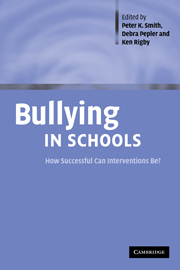Book contents
- Frontmatter
- Contents
- List of figures
- List of tables
- Notes on contributors
- Preface
- 1 Working to prevent school bullying: key issues
- 2 The Olweus Bullying Prevention Programme: design and implementation issues and a new national initiative in Norway
- 3 Is the direct approach to reducing bullying always the best?
- 4 Implementation of the Olweus Bullying Prevention programme in the Southeastern United States
- 5 Prevention of bullying in German schools: an evaluation of an anti-bullying approach
- 6 England: the Sheffield project
- 7 Making a difference in bullying: evaluation of a systemic school-based programme in Canada
- 8 Interventions against bullying in Flemish Schools: programme development and evaluation
- 9 SAVE model: an anti-bullying intervention in Spain
- 10 Australia: the Friendly Schools project
- 11 The Expect Respect project: preventing bullying and sexual harassment in US elementary schools
- 12 A follow-up survey of anti-bullying interventions in the comprehensive schools of Kempele in 1990–98
- 13 Targeting the group as a whole: the Finnish anti-bullying intervention
- 14 Ireland: the Donegal Primary Schools' anti-bullying project
- 15 Bernese programme against victimisation in kindergarten and elementary school
- 16 Looking back and looking forward: implications for making interventions work effectively
- Author index
- Subject index
- References
12 - A follow-up survey of anti-bullying interventions in the comprehensive schools of Kempele in 1990–98
Published online by Cambridge University Press: 02 December 2009
- Frontmatter
- Contents
- List of figures
- List of tables
- Notes on contributors
- Preface
- 1 Working to prevent school bullying: key issues
- 2 The Olweus Bullying Prevention Programme: design and implementation issues and a new national initiative in Norway
- 3 Is the direct approach to reducing bullying always the best?
- 4 Implementation of the Olweus Bullying Prevention programme in the Southeastern United States
- 5 Prevention of bullying in German schools: an evaluation of an anti-bullying approach
- 6 England: the Sheffield project
- 7 Making a difference in bullying: evaluation of a systemic school-based programme in Canada
- 8 Interventions against bullying in Flemish Schools: programme development and evaluation
- 9 SAVE model: an anti-bullying intervention in Spain
- 10 Australia: the Friendly Schools project
- 11 The Expect Respect project: preventing bullying and sexual harassment in US elementary schools
- 12 A follow-up survey of anti-bullying interventions in the comprehensive schools of Kempele in 1990–98
- 13 Targeting the group as a whole: the Finnish anti-bullying intervention
- 14 Ireland: the Donegal Primary Schools' anti-bullying project
- 15 Bernese programme against victimisation in kindergarten and elementary school
- 16 Looking back and looking forward: implications for making interventions work effectively
- Author index
- Subject index
- References
Summary
Impetus for the intervention study, early stages of planning, and funding
In Finland, the increase of violent behaviour and the more and more brutal forms of violence by children and adolescents were widely discussed in the 1980s. The tone of the discussion was often accusing. At times, it was the parents who were held responsible for causing this undesirable development, at other times the blame was put on schools and teachers, or it was felt that society in general was at fault by neglecting children and adolescents. To counteract this negative development, two national Finnish civic organisations, the Mannerheim League for Child Welfare (briefly Mannerheim League) and the Finnish Red Cross, launched a nationwide campaign against violence, the Non-Violent Campaign. Preparations for the campaign began in 1989, and the campaign itself was conducted in 1990. The campaign was aimed at the whole population of Finland, but the work done by Mannerheim League involved children and adolescents. One of the goals of the campaign was to raise awareness of the violence and bullying that takes place at schools, and to find ways to reduce and prevent violence. The campaign was based on a solution-oriented model, which does not so much aim to find causes and guilty parties, but rather concentrates on solving problems through constructive discussions (Pikas, 1987).
Inspired by the Non-Violent Campaign, the local Kempele association of Mannerheim League, together with the Mannerheim League district organisation, decided to carry out a survey of the prevalence and patterns of school bullying in the Kempele comprehensive schools in 1990.
- Type
- Chapter
- Information
- Bullying in SchoolsHow Successful Can Interventions Be?, pp. 235 - 250Publisher: Cambridge University PressPrint publication year: 2004
References
- 7
- Cited by

